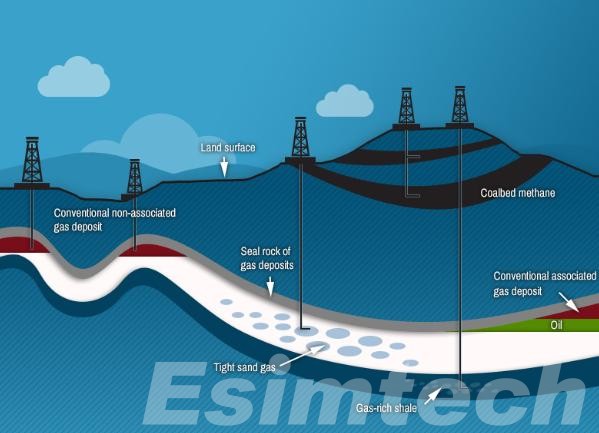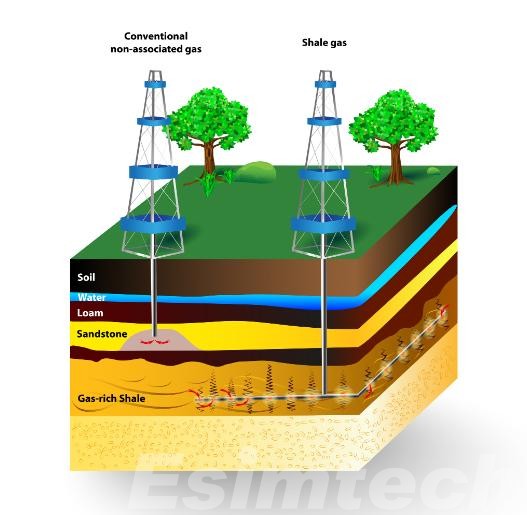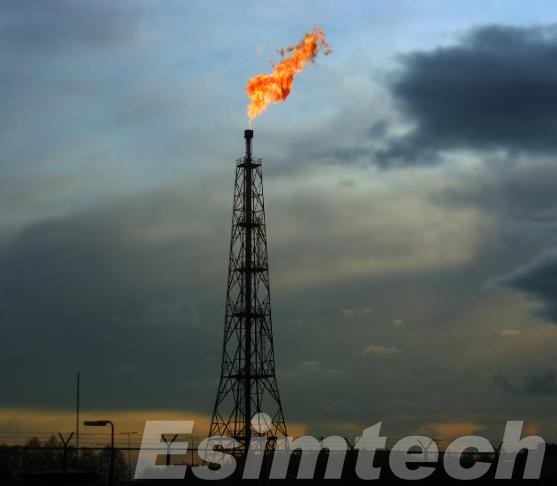Natural Gas vs. Shale Gas Production
Natural gas is an important component of the global energy structure. Compared with other fossil fuels, natural gas is highly valued for its clean combustion characteristics. However, as conventional natural gas reserves face depletion, unconventional shale gas production has become an important alternative method. This article explores natural gas and shale gas production, delving into their similarities and significant differences in the production process, as well as the economic and environmental considerations involved.
Basics of Natural Gas and Shale Gas
Natural Gas: This fossil fuel, primarily composed of methane (CH₄), is formed over millions of years from the decomposition of organic matter buried deep underground. Over time, heat and pressure transform this organic matter into a mixture of hydrocarbons, with methane being the lightest and most abundant component. Conventional natural gas is found trapped within porous rock formations like sandstone. These formations have tiny interconnected spaces that allow natural gas to accumulate over time. The pressure within these formations naturally pushes the gas towards wells drilled for extraction.

Shale Gas: Shale gas refers to unconventional natural gas that occurs in reservoir rock formations dominated by organic rich shale. It is a continuously generated biogenic gas, thermogenic gas, or a mixture of the two. Unlike conventional gas, it resides within tight, fine-grained rock formations called shale. Shale formations have a much lower permeability than sandstone, meaning the tiny spaces between rock particles are very small, hindering the natural flow of gas. This trapped gas requires a technique called hydraulic fracturing, or fracking, to create fractures in the rock and release the gas. Fracking involves injecting a high-pressure mixture of water, sand, and chemicals into the shale formation. The high pressure creates fractures in the rock, allowing the trapped gas to flow towards the wellbore for extraction.

Similarities and Differences of Natural Gas and Shale Gas Production
While both natural gas and shale gas aim to extract methane, the journey from underground reservoir to usable fuel involves distinct approaches. Here’s a closer look at the similarities and differences between these two production methods.
Similarities
- The Wellhead: Both conventional and shale gas production begin with drilling a wellbore deep underground to reach the gas-bearing rock formations.
- Exploration and Assessment: Before drilling commences, extensive geological surveys and seismic testing are conducted to identify potential gas reserves and determine the most suitable drilling locations. These techniques utilize sound waves to map the structure of underground rock formations, providing valuable insights for geologists to pinpoint promising areas for gas exploration.
- The Infrastructure Network: Once the gas is extracted, both methods rely on a vast network of pipelines to transport the raw gas to processing facilities for purification and removal of impurities. These pipelines are the arteries of the natural gas industry, spanning thousands of miles to deliver gas from production sites to consumers across vast distances.
- The Final Destination: The processed natural gas, whether conventional or shale-derived, then travels through a further network of pipelines to reach its final destination, powering homes, industries, and generating electricity. Natural gas plays a vital role in modern society, providing a cleaner-burning alternative to coal and oil for various applications.
Differences
| Feature | Conventional Natural Gas | Shale Gas |
| Reservoir Rock | Porous rock formations (sandstone) | Tight rock formations (shale) |
| Natural Gas Accumulation | Gas accumulates naturally within the pores | Gas trapped within minute cracks and pores |
| Extraction Technique | Relies on natural pressure within the reservoir | Requires hydraulic fracturing (fracking) to create fractures and release gas |
| Fracking Fluid | Not applicable | High-pressure mixture of water, sand, and chemicals |
| Environmental Impact | Generally lower | Raises concerns about water contamination, air pollution, and potential for induced earthquakes |
| Production Rate | Gradual, declines over time | Higher initial rate, shorter lifespan |
| Production Costs | Lower | Higher due to fracking |
| Infrastructure | Relies on existing well drilling and pipeline infrastructure | May require additional infrastructure for well development and transportation |
This table provides a quick overview of the key differences between conventional natural gas and shale gas production.
Both methods involve drilling wells, exploration and assessment, pipeline transportation, and final gas processing.Stricter regulations are crucial for mitigating the environmental risks associated with shale gas production.Ongoing research and development aim to improve the efficiency and sustainability of both production methods.
Economic and Environmental Considerations

The economic and environmental dimensions of natural gas and shale gas production are complex and intertwined, often presenting policymakers and stakeholders with multifaceted challenges.
Economic Considerations
Natural gas has historically been favored for its relatively low cost and abundance compared to other fossil fuels. Conventional natural gas production, with its simpler extraction methods, has traditionally offered lower upfront investment requirements and operational costs. This has made it an attractive option for meeting energy needs across various sectors, including power generation, industry, and residential heating.
However, the landscape has evolved with the advent of shale gas production. Technological advancements, particularly in hydraulic fracturing and horizontal drilling, have unlocked vast reserves of shale gas previously considered economically unviable. While shale gas production initially required substantial investments in infrastructure and technology, economies of scale and efficiency improvements have steadily driven down costs, making shale gas increasingly competitive with conventional natural gas.
From an economic standpoint, shale gas has stimulated job creation, investment opportunities, and energy security in regions with abundant shale resources. Its growing prominence has also influenced global energy markets, with implications for energy pricing, trade dynamics, and geopolitical relationships.
Economic Considerations
Natural gas has historically been favored for its relatively low cost and abundance compared to other fossil fuels. Conventional natural gas production, with its simpler extraction methods, has traditionally offered lower upfront investment requirements and operational costs. This has made it an attractive option for meeting energy needs across various sectors, including power generation, industry, and residential heating.
However, the landscape has evolved with the advent of shale gas production. Technological advancements, particularly in hydraulic fracturing and horizontal drilling, have unlocked vast reserves of shale gas previously considered economically unviable. While shale gas production initially required substantial investments in infrastructure and technology, economies of scale and efficiency improvements have steadily driven down costs, making shale gas increasingly competitive with conventional natural gas.
Conclusion
Understanding the differences between natural gas and shale gas production can help us make informed decisions about our energy future. Although shale gas holds enormous reserves and potential economic benefits, its impact on the environment requires careful consideration and stricter regulation. As we strive to seek cleaner and more sustainable energy solutions, the choice between these two resources will shape the trajectory of our energy landscape.
